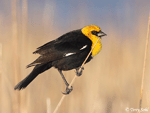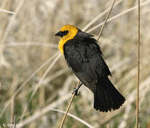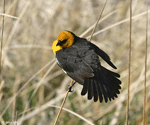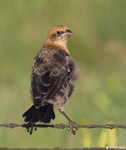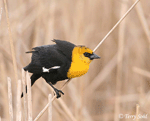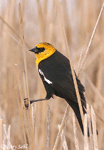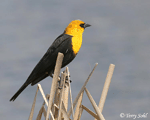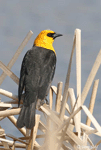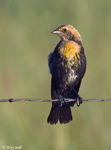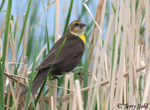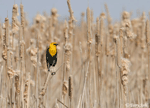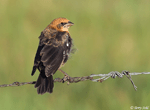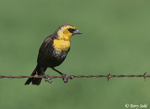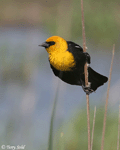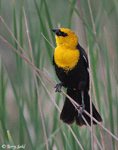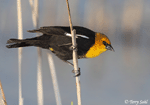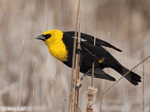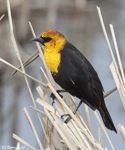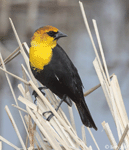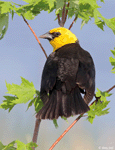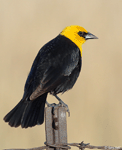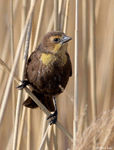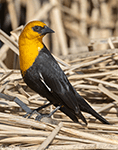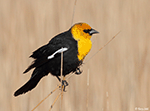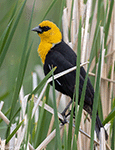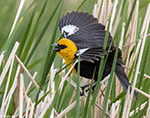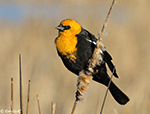Yellow-headed Blackbird
Xanthocephalus xanthocephalus
| Length: 8.5 - 11 inches | Wingspan: 14 - 17 inches | Seasonality: Summer |
| ID Keys: MALES: Yellow head and throat, black body with white wing patch. FEMALES: Females similar pattern but much duller; brown body instead of black | ||
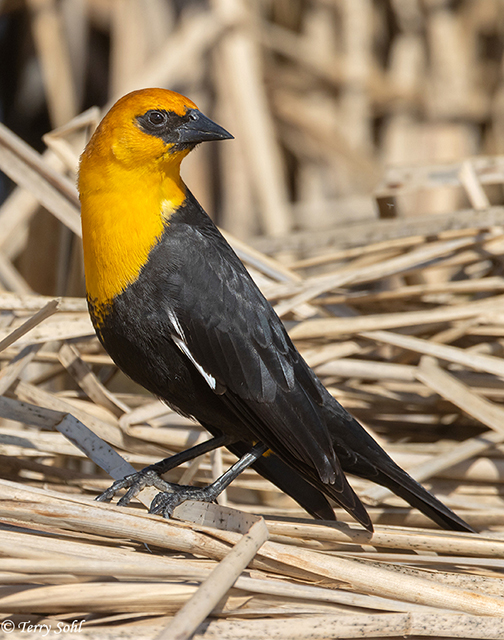 An easily identifiable
bird of marshes and sloughs, Yellow-headed Blackbirds can be found throughout
appropriate wetland habitat in the summer in South Dakota. Yellow-headed Blackbirds are described by many to have the absolute worst
male song of any U.S. bird. They usually nest in colonies in marshes
of cattails. During migration and in winter, they can sometimes be found
in huge flocks in open fields and pastures. A male is pictured at the
right; females are similar, but with much less vibrant yellow, and usually a
dark brown instead of black on the body (see photos at the bottom).
An easily identifiable
bird of marshes and sloughs, Yellow-headed Blackbirds can be found throughout
appropriate wetland habitat in the summer in South Dakota. Yellow-headed Blackbirds are described by many to have the absolute worst
male song of any U.S. bird. They usually nest in colonies in marshes
of cattails. During migration and in winter, they can sometimes be found
in huge flocks in open fields and pastures. A male is pictured at the
right; females are similar, but with much less vibrant yellow, and usually a
dark brown instead of black on the body (see photos at the bottom).
Habitat:
Freshwater sloughs, marshy lake borders, particularly those with cattail marshes or other types of wetland vegetation. Feeds around marshes, farm fields, and feedlots, and can also be found in those habitats during migration and in winter.
Diet:
Mostly seeds and insects, with the majority of the diet likely seeds.
Behavior:
Very gregarious, usually nesting in colonies. Often gathers in huge mixed flocks of blackbirds during the winter months and in migration. Feeding is done relatively close to the ground or on the ground itself, although they will also occasionally hawk insects in mid-air.
Nesting:
Late May through June in South Dakota. The nest is built entirely by the female and consists of a rather large, droopy basket woven among cattails or other wetland vegetation, suspended above the water. The female lays between 3 and 5 eggs. Incubation takes about 12 days, with the female alone incubating the eggs. The young fledge from the nest about 10 to 14 days after the eggs hatch.
Song:
Harsh, unpleasant song, with several crude warbling notes followed by a raspy ka-aaaaack. They also have short check calls.
- Click here to hear the song of a Yellow-headed Blackbird, recorded in Havasu National Wildlife Refuge in Arizona1
- Click here to hear the call of a Yellow-headed Blackbird, recorded in Sacremento County, California2
Migration:
Neotropical migrant, wintering the southwestern U.S. through Mexico and Central America.
Interactive eBird map:
Click here to access an interactive eBird map of Yellow-headed Blackbird sightings
Similar Species:
Generally distinctive. The male is the only North American bird with a black body and yellow head.
South Dakota "Hotspot":
Yellow-headed Blackbirds are quite easy to find in suitable habitat in the state, particularly in the eastern part of the state. In the "Prairie Potholes" of eastern South Dakota, Yellow-headed Blackbirds can be found nearly anywhere there are extensive areas of cattail, including both the margins of very large water bodies such as Lake Thompson, as well as quite small wetlands and pond edges. Near South Dakota's largest city of Sioux Falls, wetland habitats in western Minnehaha County always hold Yellow-headed Blackbirds from spring through early fall.
Feeders:
Given a feeder relatively close to their wetland habitats, Yellow-headed Blackbirds may attend feeders for suet, cracked corn, millet, and other seeds.
Conservation Status:
Generally stable throughout its range, although they are susceptible to habitat loss through wetland destruction. Despite the threats to their wetland habitats, numbers are stable or may even be increasing. The IUCN currently considers the Yellow-headed Blackbird to be a species of "least concern".
Further Information:
- Patuxent Bird Identification InfoCenter, Yellow-headed Blackbird
- Audubon Field Guide - Yellow-headed Blackbird
- Whatbird - Yellow-headed Blackbird
Photo Information:
May 26th, 2003 -- Western Minnehaha County -- Terry L. Sohl
Additional Photos:
Click on the image chips or text links below for additional, higher-resolution Yellow-headed Blackbird photos.
Audio File Credits:
- 1Michael Lester, XC253402. Accessible at www.xeno-canto.org/253402.
- 2Jim Holmes, XC325381. Accessible at www.xeno-canto.org/325381
| Click on the map below for a higher-resolution view |
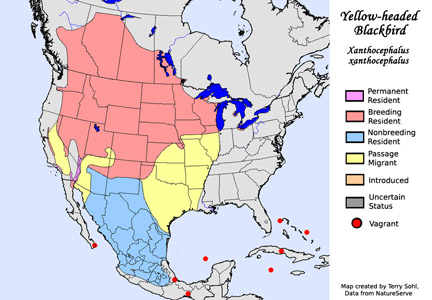 |
| South Dakota Status: Common migrant and summer resident in suitable habitat throughout the state. Accidental in winter. |
Additional Yellow-headed Blackbird Photos
Click for a higher-resolution version of these photos
